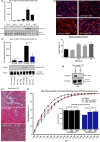In vivo GDF3 administration abrogates aging related muscle regeneration delay following acute sterile injury
- PMID: 30003692
- PMCID: PMC6156497
- DOI: 10.1111/acel.12815
In vivo GDF3 administration abrogates aging related muscle regeneration delay following acute sterile injury
Abstract
Tissue regeneration is a highly coordinated process with sequential events including immune cell infiltration, clearance of damaged tissues, and immune-supported regrowth of the tissue. Aging has a well-documented negative impact on this process globally; however, whether changes in immune cells per se are contributing to the decline in the body's ability to regenerate tissues with aging is not clearly understood. Here, we set out to characterize the dynamics of macrophage infiltration and their functional contribution to muscle regeneration by comparing young and aged animals upon acute sterile injury. Injured muscle of old mice showed markedly elevated number of macrophages, with a predominance for Ly6Chigh pro-inflammatory macrophages and a lower ratio of the Ly6Clow repair macrophages. Of interest, a recently identified repair macrophage-derived cytokine, growth differentiation factor 3 (GDF3), was markedly downregulated in injured muscle of old relative to young mice. Supplementation of recombinant GDF3 in aged mice ameliorated the inefficient regenerative response. Together, these results uncover a deficiency in the quantity and quality of infiltrating macrophages during aging and suggest that in vivo administration of GDF3 could be an effective therapeutic approach.
© 2018 The Authors. Aging Cell published by the Anatomical Society and John Wiley & Sons Ltd.
Figures


References
MeSH terms
Substances
Grants and funding
LinkOut - more resources
Full Text Sources
Other Literature Sources
Medical
Molecular Biology Databases

